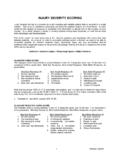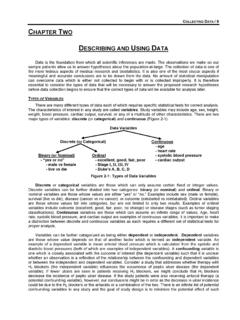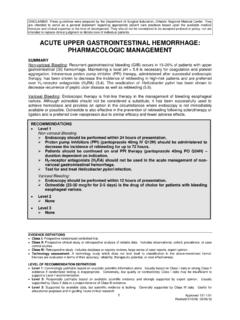Transcription of SURGICAL FIXATION OF RIB FRACTURES - …
1 DISCLAIMER: These guidelines were prepared by the Department of SURGICAL Education, Orlando Regional Medical Center. They are intended to serve as a general statement regarding appropriate patient care practices based upon the available medical literature and clinical expertise at the time of development. They should not be considered to be accepted protocol or policy, nor are intended to replace clinical judgment or dictate care of individual patients. EVIDENCE DEFINITIONS Class I: Prospective randomized controlled trial. Class II: Prospective clinical study or retrospective analysis of reliable data. Includes observational, cohort, prevalence, or case control studies. Class III: Retrospective study. Includes database or registry reviews, large series of case reports, expert opinion. Technology assessment: A technology study which does not lend itself to classification in the above-mentioned format.
2 Devices are evaluated in terms of their accuracy, reliability, therapeutic potential, or cost effectiveness. LEVEL OF RECOMMENDATION DEFINITIONS Level 1: Convincingly justifiable based on available scientific information alone. Usually based on Class I data or strong Class II evidence if randomized testing is inappropriate. Conversely, low quality or contradictory Class I data may be insufficient to support a Level I recommendation. Level 2: Reasonably justifiable based on available scientific evidence and strongly supported by expert opinion. Usually supported by Class II data or a preponderance of Class III evidence. Level 3: Supported by available data, but scientific evidence is lacking. Generally supported by Class III data. Useful for educational purposes and in guiding future clinical research. 1 Approved 2/6/2013 SURGICAL FIXATION OF RIB FRACTURES SUMMARY Rib FRACTURES are a common injury in patients sustaining blunt trauma to the chest.
3 While most rib FRACTURES heal uneventfully with conservative methods, some patients require more invasive treatment to prevent future pulmonary complications. SURGICAL FIXATION of rib FRACTURES has long been a controversial mode of treatment that has recently gained support in certain clinical circumstances. While most research on the operative treatment of rib FRACTURES takes place in the context of flail chest, various case reports and retrospective studies document its success for other select indications. INTRODUCTION In 2006, the Healthcare Cost and Utilization Project National Inpatient Sample recorded 78,856 patients admitted with multiple rib FRACTURES (1). Patients who suffer rib FRACTURES are at particular risk to develop pulmonary complications such as atelectasis, pneumonia and respiratory failure because of poor chest wall mechanics, decreased ventilatory capacity and diminished ability to cough and clear secretions.
4 Most simple rib FRACTURES are treated non-operatively using pain control and pulmonary hygiene (2). The vast majority of these injuries heal spontaneously without major complications. Severe rib FRACTURES may require the use of mechanical ventilation. Recently, there has been a resurgence of interest in the SURGICAL management of rib FRACTURES . Indications for SURGICAL FIXATION of rib FRACTURES include flail chest, severe chest wall deformity, failure to wean from mechanical ventilation, chronic pain or disability, pulmonary herniation, non-union, and "on the way out" after thoracotomy (3). Initial research suggests that in select patients, operative management of chest wall injuries is a promising treatment option. RECOMMENDATIONS Level 1 None Level 2 SURGICAL FIXATION of rib FRACTURES should be considered as the primary treatment in the following patients without severe head or other major organ system injury Flail chest segment Severe chest wall deformity with or without pulmonary herniation Symptomatic FRACTURES of 3 or more consecutive ribs Level 3 Intramedullary hardware should be employed for FIXATION of posterior rib FRACTURES to avoid extensive dissection SURGICAL FIXATION of rib FRACTURES should be considered for patients with symptomatic malunion or nonunion of rib segments (chronic therapy)
5 Absorbable plates are not recommended for FIXATION of posterior rib FRACTURES 2 Approved 2/5/2013 LITERATURE REVIEW Flail Chest Flail chest is typically defined as fracture of four or more consecutive ribs in two or more places resulting in paradoxical movement of the chest wall during respiration. There have been two prospective randomized controlled trials comparing the outcomes of SURGICAL and nonsurgical stabilization of flail chest injuries. Granetzy et al. in 2005 randomized 40 patients who experienced FRACTURES of 3 or more ribs with paradoxical movement to receive either conservative or SURGICAL treatment (4). Conservative treatment consisted of strapping and packing with elastoplast for 7-10 days. SURGICAL treatment consisted of stabilization of the rib FRACTURES using Kirschner and stainless steel wires (14 patients) or stainless steel wire only (6 patients) within 24-36 hours after admission to the Intensive care Unit (ICU).
6 Patients were excluded if they presented with head trauma affecting level of consciousness, injuries unsafe for general anesthesia, severe injury to other systems, and FRACTURES of the upper three ribs only. Both groups demonstrated significant improvement in measurements of PaO2 and PaCO2 after the interventions suggesting that both methods were effective. However, the results indicated that patients in the SURGICAL group experienced significantly fewer days on mechanical ventilation (2 vs. 12; p< ), fewer days in the ICU ( vs. ; p< ) and fewer total days in the hospital ( vs. ; p< ). Furthermore, the SURGICAL group exhibited a significantly less restrictive pattern on pulmonary function tests two months after treatment (p< ). The respective results for the SURGICAL vs. conservative group for FVC was vs. , for TLC was vs. and for FEF75 was and Stability of the chest wall was best for patients treated with Kirschner wires and stainless steel wires (100%) compared to conservative treatment or stainless steel wires only (50%).
7 With regards to morbidity, surgically treated patients demonstrated significantly fewer post-operative chest infections (10% vs. 50%), less chest wall deformity (5% vs. 45%) and fewer patients with consequential scoliosis (0% vs. 25%). The authors concluded that certain patients with flail chest who meet individualized criteria regarding age, injury severity, and cardiopulmonary status should be considered candidates for SURGICAL repair rather than mechanical ventilation. In 2002 Tanaka et al. randomized 37 patients with flail chest who required mechanical ventilation to receive SURGICAL stabilization or internal pneumatic stabilization (5). All patients required mechanical ventilation, fractured at least 6 ribs, and developed acute respiratory failure. Patients with a severe closed head and/or spinal cord injury or preexisting disease of major organ systems were excluded.
8 SURGICAL FIXATION was accomplished using Judet struts within 2 weeks after injury (mean of days) and was limited to ribs between T4 and T10. Patients in both groups were maintained on mechanical ventilation until extubation criteria were achieved. The surgically treated patients demonstrated significantly lower incidence of pneumonia at 21 days after injury (22% vs. 90%; p< ), shorter total duration on mechanical ventilation ( days vs. days; p< ), shorter duration in the trauma ICU ( days vs. days p< ), and less medical expense ($13,455 vs. $23,423 p< ). Patients who were surgically treated also demonstrated significantly better FVC compared to mechanically ventilated patients at 1, 2, 3, 6, and 12 months after injury (p< ). They also reported less chest tightness, thoracic cage pain and dyspnea compared to the conservatively treated group at 12 months after injury.
9 Furthermore, 11 of 18 patients with SURGICAL stabilization had returned to full-time employment at 6 months after injury compared to 1 of 19 in the internal pneumatic stabilization group. The findings are similar to Granetzy et al. The authors of the current study suggest that patients with multiple rib FRACTURES who may require prolonged mechanical ventilation could benefit from SURGICAL stabilization of the chest wall. A retrospective study by Ahmed et al. in 1995 compared the outcomes of 64 patients with flail chest (6). Patients with a dominant injury to another body system were excluded. All patients in this study were initially managed with intubation and mechanical ventilation. There were 26 patients who had SURGICAL stabilization of the flail segment using Kirschner wires within 12-48 hours after admission. The FIXATION occurred on only one side of the flail segment thereby converting the injury to multiple single rib FRACTURES .
10 38 patients were treated conservatively with mechanical ventilation alone. The results indicated that patients in the SURGICAL group experienced fewer days on mechanical ventilation ( vs. 15) and fewer days in the ICU (9 vs. 21). With regards to morbidity, patients in the SURGICAL group experienced fewer 3 Approved 2/5/2013 instances of chest infection (15% vs 50%), fewer instances of septicemia (4% vs. 24%), and fewer instances of tracheostomy (11% vs. 37%). The mortality of the SURGICAL group was 8% compared to 29% in the mechanically ventilated group. The researchers also note that the Kirschner wire migrated in one patient requiring removal under local anesthesia. Nonetheless, the authors conclude that SURGICAL stabilization of flail chest decreases the need for mechanical ventilation thereby improving the immediate and future outcomes of the patient.










